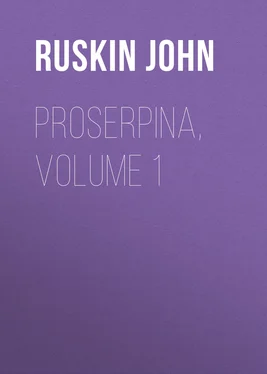John Ruskin - Proserpina, Volume 1
Здесь есть возможность читать онлайн «John Ruskin - Proserpina, Volume 1» — ознакомительный отрывок электронной книги совершенно бесплатно, а после прочтения отрывка купить полную версию. В некоторых случаях можно слушать аудио, скачать через торрент в формате fb2 и присутствует краткое содержание. Жанр: foreign_antique, Биология, literature_19, foreign_edu, на английском языке. Описание произведения, (предисловие) а так же отзывы посетителей доступны на портале библиотеки ЛибКат.
- Название:Proserpina, Volume 1
- Автор:
- Жанр:
- Год:неизвестен
- ISBN:нет данных
- Рейтинг книги:3 / 5. Голосов: 1
-
Избранное:Добавить в избранное
- Отзывы:
-
Ваша оценка:
- 60
- 1
- 2
- 3
- 4
- 5
Proserpina, Volume 1: краткое содержание, описание и аннотация
Предлагаем к чтению аннотацию, описание, краткое содержание или предисловие (зависит от того, что написал сам автор книги «Proserpina, Volume 1»). Если вы не нашли необходимую информацию о книге — напишите в комментариях, мы постараемся отыскать её.
Proserpina, Volume 1 — читать онлайн ознакомительный отрывок
Ниже представлен текст книги, разбитый по страницам. Система сохранения места последней прочитанной страницы, позволяет с удобством читать онлайн бесплатно книгу «Proserpina, Volume 1», без необходимости каждый раз заново искать на чём Вы остановились. Поставьте закладку, и сможете в любой момент перейти на страницу, на которой закончили чтение.
Интервал:
Закладка:
John Ruskin
Proserpina, Volume 1 / Studies of Wayside Flowers, While the Air was Yet Pure Among the Alps and in the Scotland and England Which My Father Knew
PROSERPINA
INTRODUCTION
Yesterday evening I was looking over the first book in which I studied Botany,—Curtis's Magazine, published in 1795 at No. 3, St. George's Crescent, Blackfriars Road, and sold by the principal booksellers in Great Britain and Ireland. Its plates are excellent, so that I am always glad to find in it the picture of a flower I know. And I came yesterday upon what I suppose to be a variety of a favourite flower of mine, called, in Curtis, "the St. Bruno's Lily."
I am obliged to say "what I suppose to be a variety," because my pet lily is branched, 1 1 At least, it throws off its flowers on each side in a bewilderingly pretty way; a real lily can't branch, I believe: but, if not, what is the use of the botanical books saying "on an unbranched stem"?
while this is drawn as unbranched, and especially stated to be so. And the page of text, in which this statement is made, is so characteristic of botanical books, and botanical science, not to say all science as hitherto taught for the blessing of mankind; and of the difficulties thereby accompanying its communication, that I extract the page entire, printing it, opposite, as nearly as possible in facsimile.
Now you observe, in this instructive page, that you have in the first place, nine names given you for one flower; and that among these nine names, you are not even at liberty to make your choice, because the united authority of Haller and Miller may be considered as an accurate balance to the single authority of Linnæus; and you ought therefore for the present to remain, yourself, balanced between the sides. You may be farther embarrassed by finding that the Anthericum of Savoy is only described as growing in Switzerland. And farther still, by finding that Mr. Miller describes two varieties of it, which differ only in size, while you are left to conjecture whether the one here figured is the larger or smaller; and how great the difference is.
Farther, If you wish to know anything of the habits of the plant, as well as its nine names, you are informed that it grows both at the bottoms of the mountains, and the tops; and that, with us, it flowers in May and June,—but you are not told when, in its native country.
The four lines of the last clause but one, may indeed be useful to gardeners; but—although I know my good father and mother did the best they could for me in buying this beautiful book; and though the admirable plates of it did their work, and taught me much, I cannot wonder that neither my infantine nor boyish mind was irresistibly attracted by the text of which this page is one of the most favourable specimens; nor, in consequence, that my botanical studies were—when I had attained the age of fifty—no farther advanced than the reader will find them in the opening chapter of this book.
ANTHERICUM Liliastrum foliis planis, scapo simplicissimo, corollis campanulatis, staminibus declinatis. Linn. Syst. Vegetab. ed. 14. Murr. p. 330. Ait. Kew. v. I. p. 449.
HEMEROCALLIS floribus patulis secundis. Hall. Hist. n. 1230.
PHALANGIUM magno flore. Bauh. Pin. 29.
PHALANGIUM Allobrogicum majus. Clus. cur. app. alt.
PHALANGIUM Allobrogicum. The Savoye Spider-wort. Park. Parad. p. 150. tab. 151. f. 1.
Botanists are divided in their opinions respecting the genus of this plant; Linnæus considers it as an Anthericum , Haller and Miller make it an Hemerocallis .
It is a native of Switzerland, where, Haller informs us it grows abundantly in the Alpine meadows, and even on the summits of the mountains; with us it flowers in May and June.
It is a plant of great elegance, producing on an unbranched stem about a foot and a half high, numerous flowers of a delicate white colour, much smaller but resembling in form those of the common white lily, possessing a considerable degree of fragrance, their beauty is heightened by the rich orange colour of their antheræ; unfortunately they are but of short duration.
Miller describes two varieties of it differing merely in size.
A loamy soil, a situation moderately moist, with an eastern or western exposure, suits this plant best; so situated, it will increase by its roots, though not very fast, and by parting of these in the autumn, it is usually propagated.
Parkinson describes and figures it in his Parad. Terrest. , observing that "divers allured by the beauty of its flowers, had brought it into these parts."
Which said book was therefore undertaken, to put, if it might be, some elements of the science of botany into a form more tenable by ordinary human and childish faculties; or—for I can scarcely say I have yet any tenure of it myself—to make the paths of approach to it more pleasant. In fact, I only know, of it, the pleasant distant effects which it bears to simple eyes; and some pretty mists and mysteries, which I invite my young readers to pierce, as they may, for themselves,—my power of guiding them being only for a little way.
Pretty mysteries, I say, as opposed to the vulgar and ugly mysteries of the so-called science of botany,—exemplified sufficiently in this chosen page. Respecting which, please observe farther;—Nobody—I can say this very boldly—loves Latin more dearly than I; but, precisely because I do love it (as well as for other reasons), I have always insisted that books, whether scientific or not, ought to be written either in Latin, or English; and not in a doggish mixture of the refuse of both.
Linnæus wrote a noble book of universal Natural History in Latin. It is one of the permanent classical treasures of the world. And if any scientific man thinks his labors are worth the world's attention, let him, also, write what he has to say in Latin, finishedly and exquisitely, if it take him a month to a page. 2 2 I have by happy chance just added to my Oxford library the poet Gray's copy of Linnæus, with its exquisitely written Latin notes, exemplary alike to scholar and naturalist.
But if—which, unless he be one chosen of millions, is assuredly the fact—his lucubrations are only of local and temporary consequence, let him write, as clearly as he can, in his native language.
This book, accordingly, I have written in English; (not, by the way, that I could have written it in anything else—so there are small thanks to me); and one of its purposes is to interpret, for young English readers, the necessary European Latin or Greek names of flowers, and to make them vivid and vital to their understandings. But two great difficulties occur in doing this. The first, that there are generally from three or four, up to two dozen, Latin names current for every flower; and every new botanist thinks his eminence only to be properly asserted by adding another.
The second, and a much more serious one, is of the Devil's own contriving—(and remember I am always quite serious when I speak of the Devil,)—namely, that the most current and authoritative names are apt to be founded on some unclean or debasing association, so that to interpret them is to defile the reader's mind. I will give no instance; too many will at once occur to any learned reader, and the unlearned I need not vex with so much as one: but, in such cases, since I could only take refuge in the untranslated word by leaving other Greek or Latin words also untranslated, and the nomenclature still entirely senseless,—and I do not choose to do this,—there is only one other course open to me, namely, to substitute boldly, to my own pupils, other generic names for the plants thus faultfully hitherto titled.
Читать дальшеИнтервал:
Закладка:
Похожие книги на «Proserpina, Volume 1»
Представляем Вашему вниманию похожие книги на «Proserpina, Volume 1» списком для выбора. Мы отобрали схожую по названию и смыслу литературу в надежде предоставить читателям больше вариантов отыскать новые, интересные, ещё непрочитанные произведения.
Обсуждение, отзывы о книге «Proserpina, Volume 1» и просто собственные мнения читателей. Оставьте ваши комментарии, напишите, что Вы думаете о произведении, его смысле или главных героях. Укажите что конкретно понравилось, а что нет, и почему Вы так считаете.












